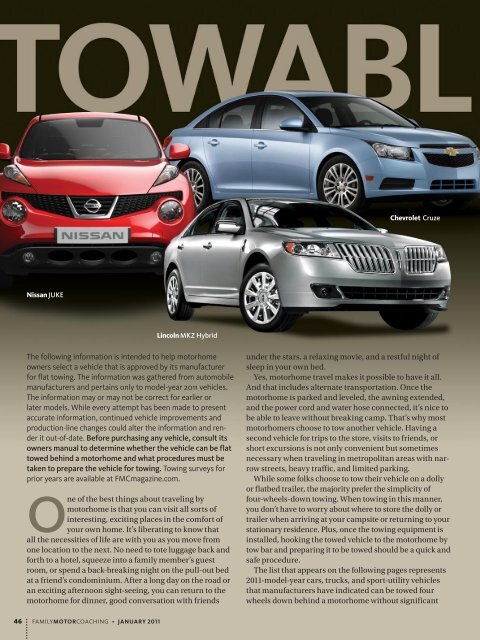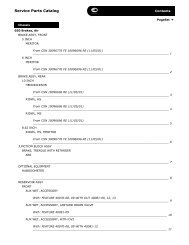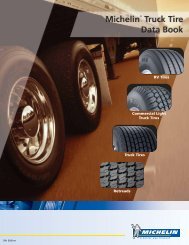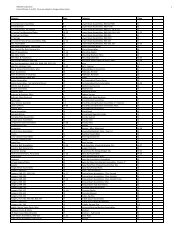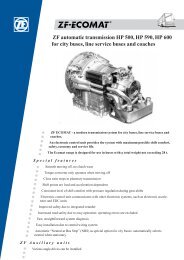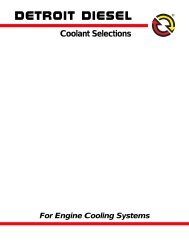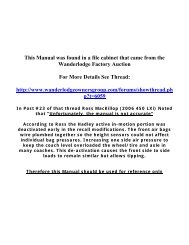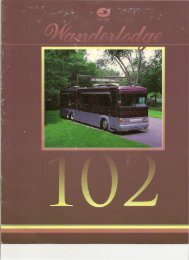The following information is intended to help motorhome owners ...
The following information is intended to help motorhome owners ...
The following information is intended to help motorhome owners ...
- No tags were found...
You also want an ePaper? Increase the reach of your titles
YUMPU automatically turns print PDFs into web optimized ePapers that Google loves.
Chevrolet CruzeN<strong>is</strong>san JUKELincoln MKZ Hybrid<strong>The</strong> <strong>following</strong> <strong>information</strong> <strong>is</strong> <strong>intended</strong> <strong>to</strong> <strong>help</strong> mo<strong>to</strong>rhome<strong>owners</strong> select a vehicle that <strong>is</strong> approved by its manufacturerfor flat <strong>to</strong>wing. <strong>The</strong> <strong>information</strong> was gathered from au<strong>to</strong>mobilemanufacturers and pertains only <strong>to</strong> model-year 2011 vehicles.<strong>The</strong> <strong>information</strong> may or may not be correct for earlier orlater models. While every attempt has been made <strong>to</strong> presentaccurate <strong>information</strong>, continued vehicle improvements andproduction-line changes could alter the <strong>information</strong> and renderit out-of-date. Before purchasing any vehicle, consult its<strong>owners</strong> manual <strong>to</strong> determine whether the vehicle can be flat<strong>to</strong>wed behind a mo<strong>to</strong>rhome and what procedures must betaken <strong>to</strong> prepare the vehicle for <strong>to</strong>wing. Towing surveys forprior years are available at FMCmagazine.com.One of the best things about traveling bymo<strong>to</strong>rhome <strong>is</strong> that you can v<strong>is</strong>it all sorts ofinteresting, exciting places in the comfort ofyour own home. It’s liberating <strong>to</strong> know thatall the necessities of life are with you as you move fromone location <strong>to</strong> the next. No need <strong>to</strong> <strong>to</strong>te luggage back andforth <strong>to</strong> a hotel, squeeze in<strong>to</strong> a family member’s guestroom, or spend a back-breaking night on the pull-out bedat a friend’s condominium. After a long day on the road oran exciting afternoon sight-seeing, you can return <strong>to</strong> themo<strong>to</strong>rhome for dinner, good conversation with friendsunder the stars, a relaxing movie, and a restful night ofsleep in your own bed.Yes, mo<strong>to</strong>rhome travel makes it possible <strong>to</strong> have it all.And that includes alternate transportation. Once themo<strong>to</strong>rhome <strong>is</strong> parked and leveled, the awning extended,and the power cord and water hose connected, it’s nice <strong>to</strong>be able <strong>to</strong> leave without breaking camp. That’s why mostmo<strong>to</strong>rhomers choose <strong>to</strong> <strong>to</strong>w another vehicle. Having asecond vehicle for trips <strong>to</strong> the s<strong>to</strong>re, v<strong>is</strong>its <strong>to</strong> friends, orshort excursions <strong>is</strong> not only convenient but sometimesnecessary when traveling in metropolitan areas with narrowstreets, heavy traffic, and limited parking.While some folks choose <strong>to</strong> <strong>to</strong>w their vehicle on a dollyor flatbed trailer, the majority prefer the simplicity offour-wheels-down <strong>to</strong>wing. When <strong>to</strong>wing in th<strong>is</strong> manner,you don’t have <strong>to</strong> worry about where <strong>to</strong> s<strong>to</strong>re the dolly ortrailer when arriving at your campsite or returning <strong>to</strong> yourstationary residence. Plus, once the <strong>to</strong>wing equipment <strong>is</strong>installed, hooking the <strong>to</strong>wed vehicle <strong>to</strong> the mo<strong>to</strong>rhome by<strong>to</strong>w bar and preparing it <strong>to</strong> be <strong>to</strong>wed should be a quick andsafe procedure.<strong>The</strong> l<strong>is</strong>t that appears on the <strong>following</strong> pages represents2011-model-year cars, trucks, and sport-utility vehiclesthat manufacturers have indicated can be <strong>to</strong>wed fourwheels down behind a mo<strong>to</strong>rhome without significant46 familymo<strong>to</strong>rcoaching • January 2011
forFord FiestaBuick Regalmodifications. You will find that th<strong>is</strong> year’s l<strong>is</strong>t includesmany familiar models that have been deemed <strong>to</strong>wable inpast years, plus several new models that may be of interest<strong>to</strong> those searching for a new <strong>to</strong>wed vehicle.You also may notice that several companies or vehiclesincluded in previous <strong>to</strong>wing guides are m<strong>is</strong>sing th<strong>is</strong> year.No longer included <strong>is</strong> General Mo<strong>to</strong>rs’ Hummer brand,which ceased production last year. Representatives fromMazda indicated that the company no longer approves itsvehicles <strong>to</strong> be <strong>to</strong>wed four wheels down. And beginning inearly 2011, Mercury will cease production. However, thecompany has been building 2011-model-year vehicles;thus, you will see Mariner and Milan vehicles on th<strong>is</strong> year’sl<strong>is</strong>t, although they may not be available later in the year.One of the additions <strong>to</strong> the 2011 <strong>to</strong>wables l<strong>is</strong>t <strong>is</strong> the BuickRegal 2.4-liter midsize sedan, which <strong>is</strong> a front-wheel-drivevehicle equipped with a six-speed au<strong>to</strong>matic transm<strong>is</strong>sion.Chevrolet, a General Mo<strong>to</strong>rs s<strong>is</strong>ter company <strong>to</strong> Buick,added the compact-size Cruze. Th<strong>is</strong> front-wheel-drivevehicle can be flat <strong>to</strong>wed when equipped with a manualtransm<strong>is</strong>sion. Models with an au<strong>to</strong>matic transm<strong>is</strong>sioncannot be flat <strong>to</strong>wed.New <strong>to</strong> the Ford stable of <strong>to</strong>wed vehicles th<strong>is</strong> year <strong>is</strong> thefront-wheel-drive Fiesta. Th<strong>is</strong> small passenger car, which<strong>is</strong> available as a four-door sedan or a five-door hatchback,A guide <strong>to</strong>2011-model-yearvehicles thatmanufacturers haveindicated can berecreationally <strong>to</strong>wedbehind a mo<strong>to</strong>rhomewithout significantmodifications.weighs just over 2,500 pounds and <strong>is</strong> <strong>to</strong>wable with eithera manual or au<strong>to</strong>matic transm<strong>is</strong>sion. Lincoln indicatedthat its front-wheel-drive MKZ Hybrid luxury sedan withau<strong>to</strong>matic transm<strong>is</strong>sion <strong>is</strong> approved for <strong>to</strong>wing.N<strong>is</strong>san’s latest addition <strong>to</strong> its <strong>to</strong>wables lineup <strong>is</strong> theJUKE, which the company <strong>to</strong>uts as a cross between asports car and an SUV. Th<strong>is</strong> front-wheel-drive vehicle <strong>is</strong><strong>to</strong>wable when equipped with a manual transm<strong>is</strong>sion.A note of caution <strong>to</strong> folks interested in purchasing FordEscape and Fusion vehicles. While these vehicles areapproved by the manufacturer <strong>to</strong> be flat <strong>to</strong>wed and canbe found on th<strong>is</strong> year’s l<strong>is</strong>t, Family Mo<strong>to</strong>r Coaching hasreceived several calls from members who have experiencedmultiple transm<strong>is</strong>sion failures reportedly associatedwith <strong>to</strong>wing 2009 and 2010 models of these vehicles.In each instance, members indicated that Ford covered allrepair and replacement costs.LET THE SEARCH BEGINTowing <strong>information</strong> may be difficult <strong>to</strong> obtain directlyfrom the au<strong>to</strong> manufacturers, and oftentimes dealershipsalespeople don’t understand the concept of recreational<strong>to</strong>wing or have limited knowledge about which vehiclescan be <strong>to</strong>wed four wheels down.continued »January 2011 • familymo<strong>to</strong>rcoaching 47
That’s why it’s important <strong>to</strong> do your homework whenit comes <strong>to</strong> selecting your next <strong>to</strong>wed vehicle. Think ofthe “Towables For 2011” guide as the first step in yourd<strong>is</strong>covery process.Actually, several steps must be taken prior <strong>to</strong> purchasinga <strong>to</strong>wed vehicle. First, make sure the dealershiprepresentative with whom you are speaking understandsthat you are looking <strong>to</strong> <strong>to</strong>w the vehicle and not <strong>to</strong> use it <strong>to</strong><strong>to</strong>w a trailer.Next, and perhaps the most important step, <strong>is</strong> <strong>to</strong> requestthat the salesperson show you a copy of the <strong>owners</strong> manualfor that vehicle. No vehicle should leave the lot withou<strong>to</strong>ne, so ins<strong>is</strong>t upon seeing it. Once you have the manual inhand, find the section that addresses four-wheels-down<strong>to</strong>wing — often under a heading such as “RecreationalTowing.” (Do not confuse th<strong>is</strong> with “Emergency Towing,”which may be possible four wheels down on a limitedbas<strong>is</strong> for emergency purposes only.) In th<strong>is</strong> section youwill find the specific guidelines regarding the <strong>to</strong>wing procedures,necessary modifications, and safety <strong>is</strong>sues pertaining<strong>to</strong> the particular vehicle. Keep in mind that whilea manufacturer may say a vehicle can be <strong>to</strong>wed withoutsignificant modifications, what may not be significant <strong>to</strong>one person may be burdensome <strong>to</strong> another.Once you are confident that the vehicle <strong>is</strong> <strong>to</strong>wable andyou are comfortable with the <strong>to</strong>wing setup proceduresand guidelines, you should have a few more questionsanswered before making the purchase. Find out fromthe dealer, manufacturer, or <strong>owners</strong> manual how <strong>to</strong>wingwill affect the vehicle’s warranty. Also, ask the dealer repwhether any service bulletins have been released thatrelate <strong>to</strong> <strong>to</strong>wing the vehicle behind a mo<strong>to</strong>rhome.Finally, if possible, have the vehicle weighed. Yourmo<strong>to</strong>rhome has been given a gross combination weightrating (GCWR), which <strong>is</strong> the maximum allowable combinedweight of the mo<strong>to</strong>rhome and the attached <strong>to</strong>wedvehicle. <strong>The</strong> <strong>following</strong> l<strong>is</strong>t includes approximate curbweights as supplied by the manufacturers; however,optional equipment and accessories undoubtedly willincrease the weight of the vehicle. So, make sure thatits weight will not push the combined weight above theGCWR. It’s also a good idea <strong>to</strong> weigh your mo<strong>to</strong>rhome (see“Weight And Tire Safety,” July 2007, page 62). Because ofoverloading <strong>is</strong>sues, some mo<strong>to</strong>rhomes should not be <strong>to</strong>winganything. In fact, certain mo<strong>to</strong>rhomes may need <strong>to</strong>have their loads lightened before being driven solo.<strong>The</strong> next step <strong>is</strong> <strong>to</strong> purchase a <strong>to</strong>w bar and base plate.Several companies sell <strong>to</strong>w bars with varying convenienceand safety features. <strong>The</strong> most important fac<strong>to</strong>r whenselecting a <strong>to</strong>w bar and base plate package <strong>is</strong> <strong>to</strong> make sureit <strong>is</strong> rated <strong>to</strong> handle the weight of the <strong>to</strong>wed vehicle. Onceyou’ve made your choice, have the initial installation doneby knowledgeable, qualified, and experienced personnel.Once the equipment <strong>is</strong> installed, it’s imperative that allequipment be checked frequently and used only in themanner for which it was designed. As with any mechanicalgear, proper maintenance can increase the life of<strong>to</strong>wing equipment. However, there comes a time when theequipment must be replaced <strong>to</strong> prevent a dangerous situation.Frequent inspections will alert you <strong>to</strong> the need.When hooking up the <strong>to</strong>wed vehicle, do not let yourselfbe d<strong>is</strong>tracted. We’ve all heard s<strong>to</strong>ries about someonewho had a weld break or who forgot <strong>to</strong> connect the safetychains but was fortunate enough that nothing bad happened.Others were not so lucky, and they know that thepersonal and financial costs of a <strong>to</strong>wing m<strong>is</strong>hap can beenormous.Also, get in the habit of checking the <strong>to</strong>w bar, connec<strong>to</strong>rpins, safety chains, and electrical connection eachtime you s<strong>to</strong>p for fuel or <strong>to</strong> take a rest break. Walk aroundthe <strong>to</strong>wed vehicle <strong>to</strong> make sure the tires are properlyinflated and are not exhibiting any unusual wear patterns.Perform these quick safety inspections each time you’res<strong>to</strong>pped and you will decrease the chances of a potentialproblem while on the road.Safety <strong>is</strong> the most important <strong>is</strong>sue for mo<strong>to</strong>rhomerswhen they operate their coaches. That’s why, for safety’ssake, every mo<strong>to</strong>rhome owner who <strong>to</strong>ws a vehicle fourwheels down should consider using an auxiliary brakingsystem. Many mo<strong>to</strong>rhome, chass<strong>is</strong>, and au<strong>to</strong>mobilemanufacturers recommend that supplemental brakesbe used on any <strong>to</strong>wed vehicle. Check your mo<strong>to</strong>rhome’s<strong>owners</strong> manual and you likely will find requirements and<strong>information</strong> regarding the use of auxiliary brakes.A question that <strong>is</strong> often asked concerning supplementalbrakes involves the legal ramifications of not usingone. Not all jur<strong>is</strong>dictions mandate supplemental brakeson <strong>to</strong>wed vehicles, but when it comes <strong>to</strong> four-wheelsdown<strong>to</strong>wing, safety should be more important thanwhether you are likely <strong>to</strong> receive a traffic citation. Yourmo<strong>to</strong>rhome’s brakes were designed <strong>to</strong> s<strong>to</strong>p the weight ofthe coach. Add several thousand pounds of <strong>to</strong>wed vehicleweight <strong>to</strong> the equation, and the mo<strong>to</strong>rhome’s brakingsystem <strong>is</strong> being asked <strong>to</strong> do more than it was <strong>intended</strong>. <strong>The</strong>extra weight can reducethe effectiveness of the brakes in emergency s<strong>to</strong>ppingsituations, as well as lead <strong>to</strong> premature — and potentiallycostly — wear on the mo<strong>to</strong>rhome’s braking system.A supplemental brake provides s<strong>to</strong>pping ass<strong>is</strong>tance<strong>to</strong> the tandem, allowing the <strong>to</strong>wed vehicle’s brakes <strong>to</strong>slow the vehicle and reduce the weight inertia that’spushing forward against the rear of the mo<strong>to</strong>rhome.Most of us have never heard anyone say that the brakeson their mo<strong>to</strong>rhome s<strong>to</strong>p it <strong>to</strong>o quickly. Nevertheless,many of us have seen what happens when brakes don’twork quickly enough.Although th<strong>is</strong> guide focuses on vehicles that can be flat<strong>to</strong>wed, there <strong>is</strong> no single best way <strong>to</strong> <strong>to</strong>w. Each vehicle andeach method has its advantages and d<strong>is</strong>advantages. If avehicle you already own or w<strong>is</strong>h <strong>to</strong> purchase cannot be flat<strong>to</strong>wed, it may be possible <strong>to</strong> <strong>to</strong>w it on a dolly or trailer orhave adaptations made <strong>to</strong> the vehicle <strong>to</strong> make it <strong>to</strong>wable.48 familymo<strong>to</strong>rcoaching • January 2011
Buick Enclave CXLCadillac Escalade HybridREADING THE CHARTBased on questions we’ve received from readers in past years, here are some clarifications regarding <strong>information</strong> that appears onthe accompanying <strong>to</strong>wing chart. A “Yes” in the column under the type of transm<strong>is</strong>sion (au<strong>to</strong> or manual) means that when equippedwith that type of transm<strong>is</strong>sion, the vehicle <strong>is</strong> <strong>to</strong>wable; “No” means it <strong>is</strong> not <strong>to</strong>wable. If the model <strong>is</strong> not available with a particulartransm<strong>is</strong>sion, “N/A” appears in the column. <strong>The</strong> “Approximate Curb Weight” and “Total Length” figures are for a vehicle’s basemodel. Keep in mind also that although some vehicles are indicated as being <strong>to</strong>wable, not all trim lines, engine configurations, etc.within that model line may be <strong>to</strong>wable; always refer <strong>to</strong> the particular vehicle’s <strong>owners</strong> manual <strong>to</strong> be sure.BUICKModelTransm<strong>is</strong>sionAu<strong>to</strong> ManualDriveConfigurationSpeed/D<strong>is</strong>tanceLimitsApproximateCurb WeightTotalLengthEnclave CX, CXL Yes N/A All-wheel drive 65 mph/None 4,985 lbs. 201.5 in.Enclave CX, CXL Yes N/A Front-wheel drive 65 mph/None 4,780 lbs. 201.5 in.LaCrosse CXL Yes N/A All-wheel drive None 4,196 lbs. 196.9 in.LaCrosse CX, CXL, CXS Yes N/A Front-wheel drive None 3,829 lbs. 196.9 in.Regal 2.4-liter Yes N/A Front-wheel drive 65 mph/None 3,600 lbs. 190.2 in.CADILLACModelTransm<strong>is</strong>sionAu<strong>to</strong> ManualDriveConfigurationSpeed/D<strong>is</strong>tanceLimitsApproximateCurb WeightTotalLengthEscalade Hybrid Yes N/A Four-wheel drive None 6,120 lbs. 202.5 in.SRX 3.0-liter V-6 Yes N/A All-wheel drive 65 mph/None 4,307 lbs. 190.3 in.SRX 3.0-liter V-6 Yes N/A Front-wheel drive 65 mph/None 4,224 lbs. 190.3 in.CHEVROLET continues on page 50 >>ModelTransm<strong>is</strong>sionAu<strong>to</strong> ManualDriveConfigurationSpeed/D<strong>is</strong>tanceLimitsApproximateCurb WeightTotalLengthAvalanche* Yes N/A Four-wheel drive None 5,942 lbs. 221.3 in.Colorado Yes Yes Four-wheel drive None 3,584 lbs. 192.4 in.* Only vehicles with a two-speed au<strong>to</strong>matic transfer case can be <strong>to</strong>wed four wheels down.January 2011 • familymo<strong>to</strong>rcoaching 49
Chevrolet HHRDodge DakotaCHEVROLET continuedModelTransm<strong>is</strong>sionAu<strong>to</strong> ManualDriveConfigurationSpeed/D<strong>is</strong>tanceLimitsApproximateCurb WeightTotalLengthCruze No Yes Front-wheel drive None 3,102 lbs. 181.0 in.Equinox Yes N/A All-wheel drive 65 mph/None 3,951 lbs. 187.8 in.Equinox Yes N/A Front-wheel drive 65 mph/None 3,786 lbs. 187.8 in.HHR Yes Yes Front-wheel drive 65 mph/None 3,155 lbs. 176.2 in.Malibu Yes N/A Front-wheel drive 65 mph/None 3,415 lbs. 191.8 in.Silverado 1500 Yes N/A Four-wheel drive None 4,892 lbs. 205.6 in.Silverado 2500 Yes N/A Four-wheel drive None 5,920 lbs. 225.0 in.Silverado 3500 Yes N/A Four-wheel drive None 6,134 lbs. 225.0 in.Silverado Hybrid Yes N/A Four-wheel drive None 5,882 lbs. 230.0 in.Suburban 1500* Yes N/A Four-wheel drive None 5,921 lbs. 224.4 in.Suburban 2500* Yes N/A Four-wheel drive None 6,447 lbs. 224.4 in.Tahoe* Yes N/A Four-wheel drive None 5,814 lbs. 202.0 in.Tahoe Hybrid Yes N/A Four-wheel drive None 5,891 lbs. 202.0 in.Traverse Yes N/A All-wheel drive 65 mph/None 4,925 lbs. 205.0 in.Traverse Yes N/A Front-wheel drive 65 mph/None 4,720 lbs. 205.0 in.* Only vehicles with a two-speed au<strong>to</strong>matic transfer case can be <strong>to</strong>wed four wheels down.DODGEModelTransm<strong>is</strong>sionAu<strong>to</strong> ManualDriveConfigurationSpeed/D<strong>is</strong>tanceLimitsApproximateCurb WeightTotalLengthDakota* Yes N/A Four-wheel drive None 4,382 lbs. 218.5 in.Ram 1500 † Yes N/A Four-wheel drive None 4,860 lbs. 209.0 in.Ram 2500 † Yes Yes Four-wheel drive None 6,246 lbs. 231.0 in.Ram 3500 † Yes Yes Four-wheel drive None 6,965 lbs. 231.0 in.* Requires the negative battery cable <strong>to</strong> be d<strong>is</strong>connected while <strong>to</strong>wing.†See detailed procedure in the 2011 Dodge Ram 1500/2500/3500 <strong>owners</strong> manual, pages 471-48050 familymo<strong>to</strong>rcoaching • January 2011
Honda FitHyundai Elantra TouringFORD continuedModelTransm<strong>is</strong>sionAu<strong>to</strong> ManualDriveConfigurationSpeed/D<strong>is</strong>tanceLimitsApproximateCurb WeightTotalLengthRanger 4x2 § No Yes Rear-wheel drive 55 mph/None 3,128 lbs. 189.4 in.Taurus Yes N/A All-wheel drive 65 mph/None 4,224 lbs. 202.9 in.Taurus Yes N/A Front-wheel drive 65 mph/None 4,015 lbs. 202.9 in.* Vehicles equipped with au<strong>to</strong>matic transm<strong>is</strong>sions should not exceed 65 mph; vehicles equipped with manual transm<strong>is</strong>sions should not exceed 70 mph.†Only with manual-shift transfer case 4x4 vehicles, not electronic shift-on-the-fly or 4x2 vehicles. Manual transfer case shifted in<strong>to</strong> “neutral.”‡<strong>The</strong> Fusion Sport with a 3.5-liter V-6 engine <strong>is</strong> not <strong>to</strong>wable four wheels down.§Manual transm<strong>is</strong>sion in “neutral.” Four-wheel drive only: Electronic shift-on-the-fly rotary control in 2-high position and transm<strong>is</strong>sion in “neutral.”GMCModelTransm<strong>is</strong>sionAu<strong>to</strong> ManualDriveConfigurationSpeed/D<strong>is</strong>tanceLimitsApproximateCurb WeightTotalLengthAcadia Yes N/A All-wheel drive 65 mph/None 4,925 lbs. 201.1 in.Acadia Yes N/A Front-wheel drive 65 mph/None 4,720 lbs. 201.1 in.Canyon Yes Yes Four-wheel drive None 3,684 lbs. 192.4 in.Sierra 1500 Yes N/A Four-wheel drive None 4,877 lbs. 205.6 in.Sierra Hybrid Yes N/A Four-wheel drive None 5,781 lbs. 230.0 in.Terrain Yes N/A All-wheel drive 65 mph/None 3,798 lbs. 185.3 in.Terrain Yes N/A Front-wheel drive 65 mph/None 3,798 lbs. 185.3 in.Yukon* Yes N/A Four-wheel drive None 5,265 lbs. 202.0 in.Yukon XL* Yes N/A Four-wheel drive None 5,524 lbs. 224.4 in.Yukon Hybrid Yes N/A Four-wheel drive None 5,874 lbs. 202.0 in.* Only vehicles with a two-speed au<strong>to</strong>matic transfer case can be <strong>to</strong>wed four wheels down.52 familymo<strong>to</strong>rcoaching • January 2011
Infiniti G37 CoupeJeep Grand CherokeeHONDAModelTransm<strong>is</strong>sionAu<strong>to</strong> ManualDriveConfigurationSpeed/D<strong>is</strong>tanceLimitsApproximateCurb WeightTotalLengthCR-V 4x4 Yes N/A Four-wheel drive 65 mph/None* 3,503 lbs. 179.3 in.CR-V 4x2 Yes N/A Front-wheel drive 65 mph/None* 3,386 lbs. 179.3 in.Fit Yes Yes Front-wheel drive 65 mph/None* 2,489 lbs. 161.6 in.* Special procedure required for every 8 hours of <strong>to</strong>wing <strong>to</strong> avoid severe transm<strong>is</strong>sion damage. Please refer <strong>to</strong> the <strong>owners</strong> manual for full details.HYUNDAIModelTransm<strong>is</strong>sionAu<strong>to</strong> ManualDriveConfigurationSpeed/D<strong>is</strong>tanceLimitsApproximateCurb WeightTotalLengthAccent No Yes Front-wheel drive None 2,365 lbs. 168.5 in.Elantra No Yes Front-wheel drive None 2,661 lbs. 178.3 in.Elantra Touring No Yes Front-wheel drive None 2,937 lbs. 176.6 in.Genes<strong>is</strong> Coupe No Yes Rear-wheel drive None 3,294 lbs. 182.3 in.Santa Fe No Yes Front-wheel drive None 3,688 lbs. 184.1 in.Sonata No Yes Front-wheel drive None 3,161 lbs. 189.8 in.Tucson No Yes Front-wheel drive None 3,179 lbs. 173.2 in.INFINITIModelTransm<strong>is</strong>sionAu<strong>to</strong> ManualDriveConfigurationSpeed/D<strong>is</strong>tanceLimitsApproximateCurb WeightTotalLengthG37 Convertible No Yes Rear-wheel drive 70 mph/500 mi.* 4,103 lbs. 183.3 in.G37 Coupe No Yes Rear-wheel drive 70 mph/500 mi.* 3,710 lbs. 183.1 in.G37 Sedan No Yes Rear-wheel drive 70 mph/500 mi.* 3,701 lbs. 187.9 in.* Idle the engine in “neutral” for two minutes after every 500 miles of <strong>to</strong>wing.January 2011 • familymo<strong>to</strong>rcoaching 53
Kia Rio Lexus IS 250JEEPModelTransm<strong>is</strong>sionAu<strong>to</strong> ManualDriveConfigurationSpeed/D<strong>is</strong>tanceLimitsApproximateCurb WeightTotalLengthGrand Cherokee* Yes N/A Four-wheel drive None 4,660 lbs. 189.8 in.Liberty Yes N/A Four-wheel drive None 4,290 lbs. 176.1 in.Wrangler Yes Yes Four-wheel drive None 3,760 lbs. 152.8 in.Wrangler Unlimited Yes Yes Four-wheel drive None 4,075 lbs. 173.4 in.*Only vehicles equipped with the Quadra-Trac II/ Quadra-Drive II systems can be <strong>to</strong>wed four wheels down.KIAModelTransm<strong>is</strong>sionAu<strong>to</strong> ManualDriveConfigurationSpeed/D<strong>is</strong>tanceLimitsApproximateCurb WeightTotalLengthForte Sedan No Yes Front-wheel drive None 2,729 lbs. 178.3 in.Forte Koup No Yes Front-wheel drive None 2,737 lbs. 176.4 in.Forte 5-Door No Yes Front-wheel drive None 2,781 lbs. 170.9 in.Optima No Yes Front-wheel drive None 3,206 lbs. 190.7 in.Rio Sedan No Yes Front-wheel drive None 2,365 lbs. 166.9 in.Rio 5 No Yes Front-wheel drive None 2,438 lbs. 158.1 in.Soul 1.6-liter No Yes Front-wheel drive None 2,560 lbs. 161.6 in.Soul 2.0-liter No Yes Front-wheel drive None 2,800 lbs. 161.6 in.Soren<strong>to</strong> No Yes Front-wheel drive None 3,763 lbs. 183.9 in.Sportage 4x2 No Yes Front-wheel drive None 3,157 lbs. 174.8 in.LEXUSModelTransm<strong>is</strong>sionAu<strong>to</strong> ManualDriveConfigurationSpeed/D<strong>is</strong>tanceLimitsApproximateCurb WeightTotalLengthIS 250 No Yes Rear-wheel drive None 3,455 lbs. 180.3 in.54 familymo<strong>to</strong>rcoaching • January 2011
Lincoln MKSMercury Milan HybridLINCOLN/MERCURYModelTransm<strong>is</strong>sionAu<strong>to</strong> ManualDriveConfigurationSpeed/D<strong>is</strong>tanceLimitsApproximateCurb WeightTotalLengthMariner I-4 Yes N/A Four-wheel drive 65 mph/None 3,493 lbs. 175.1 in.Mariner I-4 Yes N/A Front-wheel drive 65 mph/None 3,341 lbs. 175.1 in.Mariner V-6 Yes N/A Four-wheel drive 65 mph/None 4,640 lbs. 175.1 in.Mariner V-6 Yes N/A Front-wheel drive 65 mph/None 4,500 lbs. 175.1 in.Mariner Hybrid Yes N/A Four-wheel drive 75 mph/None 3,825 lbs. 175.1 in.Mariner Hybrid Yes N/A Front-wheel drive 75 mph/None 3,665 lbs. 175.1 in.Milan I-4 Yes Yes Front-wheel drive Yes*/None 3,308 lbs. 189.0 in.Milan V-6 Yes N/A All-wheel drive 65 mph/None 3,699 lbs. 189.0 in.Milan V-6 Yes N/A Front-wheel drive 65 mph/None 3,462 lbs. 189.0 in.Milan Hybrid Yes N/A Front-wheel drive 65 mph/None 3,729 lbs. 189.0 in.MKS Yes N/A All-wheel drive 65 mph/None 4,276 lbs. 204.1 in.MKS Yes N/A Front-wheel drive 65 mph/None 4,127 lbs. 204.1 in.MKT Yes N/A All-wheel drive 65 mph/None 5,010 lbs. 207.6 in.MKT Yes N/A Front-wheel drive 65 mph/None 4,871 lbs. 207.6 in.MKX Yes N/A All-wheel drive 65 mph/None 4,429 lbs. 186.7 in.MKX Yes N/A Front-wheel drive 65 mph/None 4,251 lbs. 186.7 in.MKZ Hybrid Yes N/A Front-wheel drive 65 mph/None 3,756 lbs. 189.8 in.* Vehicles equipped with au<strong>to</strong>matic transm<strong>is</strong>sions should not exceed 65 mph; vehicles equipped with manual transm<strong>is</strong>sions should not exceed 70 mph.January 2011 • familymo<strong>to</strong>rcoaching 55
N<strong>is</strong>san VersaScion tCNISSANModelTransm<strong>is</strong>sionAu<strong>to</strong> ManualDriveConfigurationSpeed/D<strong>is</strong>tanceLimitsApproximateCurb WeightTotalLength370Z Coupe No Yes Rear-wheel drive 70 mph/500 mi.* 3,232 lbs. 167.2 in.370Z Roadster No Yes Rear-wheel drive 70 mph/500 mi.* 3,426 lbs. 167.2 in.Altima Coupe 2.5 S, 3.5 SR No Yes Front-wheel drive None/500 mi.* 3,080 lbs. 180.9 in.Cube No Yes Front-wheel drive 70 mph/500 mi.* 2,768 lbs. 156.7 in.Frontier Crew Cab 4x4 No Yes Four-wheel drive None/500 mi.* 4,410 lbs. 205.5 in.Frontier Crew Cab 4x2 No Yes Rear-wheel drive None/500 mi.* 4,228 lbs. 205.5 in.Frontier King Cab 4x4 No Yes Four-wheel drive None/500 mi.* 4,294 lbs. 205.5 in.Frontier King Cab I-4 4x2 No Yes Rear-wheel drive None/500 mi.* 3,685 lbs. 205.5 in.Frontier King Cab V-6 4x2 No Yes Rear-wheel drive None/500 mi.* 4,152 lbs. 205.5 in.JUKE No Yes Front-wheel drive None/500 mi.* 2,923 lbs. 162.4 in.Sentra 2.0 No Yes Front-wheel drive None/500 mi.* 2,873 lbs. 179.8 in.Versa Sedan 1.6, 1.8 S No Yes Front-wheel drive None/500 mi.* 2,516 lbs. 176.0 in.Versa Hatchback 1.8 S No Yes Front-wheel drive None/500 mi.* 2,693 lbs. 169.1 in.Xterra 4x4 No Yes Four-wheel drive None/500 mi.* 4,343 lbs. 178.7 in.* All N<strong>is</strong>san vehicles: After <strong>to</strong>wing 500 miles, idle the engine in “neutral” for two minutes <strong>to</strong> circulate the fluids.SCIONModelTransm<strong>is</strong>sionAu<strong>to</strong> ManualDriveConfigurationSpeed/D<strong>is</strong>tanceLimitsApproximateCurb WeightTotalLengthtC No Yes Front-wheel drive None 3,060 lbs. 174.0 in.xB No Yes Front-wheel drive None 3,020 lbs. 167.3 in.xD No Yes Front-wheel drive None 2,625 lbs. 154.7 in.56 familymo<strong>to</strong>rcoaching • January 2011
Smart Fortwo Passion CabrioletSubaru ImprezaSMARTModelTransm<strong>is</strong>sionAu<strong>to</strong> ManualDriveConfigurationSpeed/D<strong>is</strong>tanceLimitsApproximateCurb WeightTotalLengthSmart Fortwo Passion Coupe* N/A Yes † Rear-wheel drive None 1,808 lbs. 106.1 in.Smart Fortwo Passion Cabriolet* N/A Yes † Rear-wheel drive None 1,852 lbs. 106.1 in.* <strong>The</strong> battery must be d<strong>is</strong>connected.†<strong>The</strong> Smart Fortwo <strong>is</strong> equipped with an au<strong>to</strong>mated manual transm<strong>is</strong>sion that allows the driver <strong>to</strong> select either manual shifting or au<strong>to</strong>matic shifting options.SUBARUModelTransm<strong>is</strong>sionAu<strong>to</strong> ManualDriveConfigurationSpeed/D<strong>is</strong>tanceLimitsApproximateCurb WeightTotalLengthForester No Yes All-wheel drive None 3,250 lbs. 179.5 in.Impreza Sedan No Yes All-wheel drive None 3,075 lbs. 180.3 in.Impreza 5-Door No Yes All-wheel drive None 3,075 lbs. 173.8 in.Legacy No Yes All-wheel drive None 3,270 lbs. 186.4 in.Outback No Yes All-wheel drive None 3,386 lbs. 188.2 in.If you’re going <strong>to</strong> <strong>to</strong>w, always . . .. . . follow the <strong>to</strong>wing instructions provided in the<strong>to</strong>wed vehicle’s <strong>owners</strong> manual exactly as written.. . . make sure no one <strong>is</strong> standing between the <strong>to</strong>wedvehicle and the mo<strong>to</strong>rhome when the <strong>to</strong>wed vehicle<strong>is</strong> being positioned <strong>to</strong> be hooked up.. . . adhere <strong>to</strong> the mo<strong>to</strong>rhome’s gross combinationweight rating when <strong>to</strong>wing another vehicle.. . . check the <strong>to</strong>wing equipment – receiver, <strong>to</strong>wbar, base plate, safety chains, electrical wiring – fordamage or wear.. . . check the <strong>to</strong>wed vehicle’s tires for properinflation and condition.. . . give your undivided attention while hookingup the <strong>to</strong>wed vehicle. Complete the entire processbefore moving on <strong>to</strong> something else.. . . make sure the connections – <strong>to</strong>w bar, safetychains, electrical – are secure.. . . check the <strong>to</strong>wed vehicle’s brake lights, taillights,and turn signals <strong>to</strong> make sure they are operationalonce the vehicle <strong>is</strong> hooked up.. . . release the <strong>to</strong>wed vehicle’s parking brakeand make sure the steering wheel <strong>is</strong> unlocked, ifnecessary, before <strong>to</strong>wing.January 2011 • familymo<strong>to</strong>rcoaching 57
Suzuki Grand VitaraToyota CamrySUZUKIModelTransm<strong>is</strong>sionAu<strong>to</strong> ManualDriveConfigurationSpeed/D<strong>is</strong>tanceLimitsApproximateCurb WeightTotalLengthGrand Vitara * Yes Yes Four-wheel drive 55 mph/200 mi. † 3,611 lbs. 177.1 in.SX4 Crossover No Yes All-wheel drive 55 mph/None 2,855 lbs. 162.8 in.SX4 Sport No Yes Front-wheel drive 55 mph/None 2,668 lbs. 177.6 in.* Only Grand Vitara models equipped with the 4-mode four-wheel-drive system can be <strong>to</strong>wed four wheels down.†S<strong>to</strong>p <strong>to</strong>wing every 200 miles and follow the instructions in the <strong>owners</strong> manual <strong>to</strong> circulate the oil in the transfer case and/or transm<strong>is</strong>sion. Transfer case inneutral; au<strong>to</strong>matic transm<strong>is</strong>sion lever in “D.”TOYOTAModelTransm<strong>is</strong>sionAu<strong>to</strong> ManualDriveConfigurationSpeed/D<strong>is</strong>tanceLimitsApproximateCurb WeightTotalLengthCamry No Yes Front-wheel drive None 3,263 lbs. 189.2 in.Corolla No Yes Front-wheel drive None 2,723 lbs. 178.7 in.Matrix No Yes Front-wheel drive None 2,865 lbs. 171.9 in.Yar<strong>is</strong> Liftback No Yes Front-wheel drive None 2,313 lbs. 150.6 in.Yar<strong>is</strong> Sedan No Yes Front-wheel drive None 2,311 lbs. 169.3 in.How <strong>to</strong> make a smart <strong>to</strong>wed vehicle purchase1Make sure the dealership representative with whomyou are speaking understands that you are looking<strong>to</strong> <strong>to</strong>w the vehicle and not <strong>to</strong> use it <strong>to</strong> <strong>to</strong>w a trailer.2Request that the salesperson show you a copyof the <strong>owners</strong> manual for that vehicle and findthe section that addresses recreational <strong>to</strong>wing.3Find out from the dealer, manufacturer, or<strong>owners</strong> manual how <strong>to</strong>wing will affect thevehicle’s warranty.4Ask the dealer rep whether any service bulletinshave been released that relate <strong>to</strong> <strong>to</strong>wing thevehicle behind a mo<strong>to</strong>rhome.5Finally, if possible, have the vehicle weighed. Yourmo<strong>to</strong>rhome has been given a gross combinationweight rating (GCWR), which <strong>is</strong> the maximumallowable combined weight of the mo<strong>to</strong>rhome andthe attached <strong>to</strong>wed vehicle.58 familymo<strong>to</strong>rcoaching • January 2011


